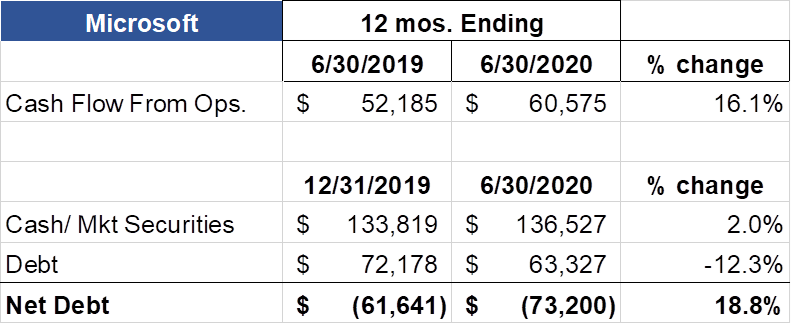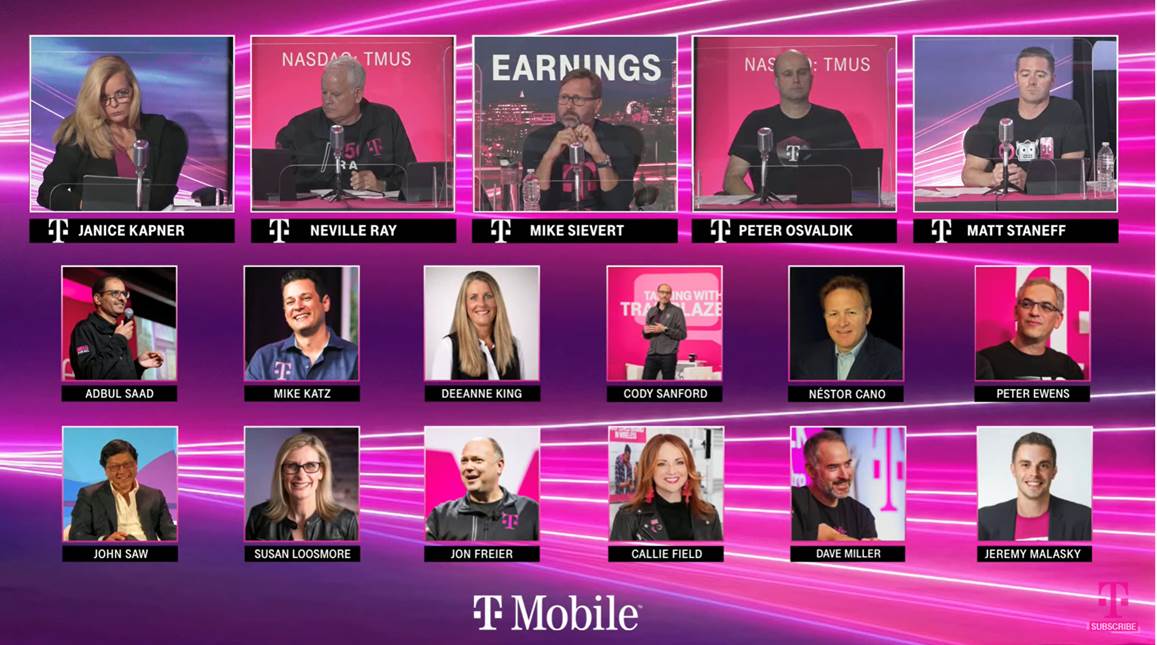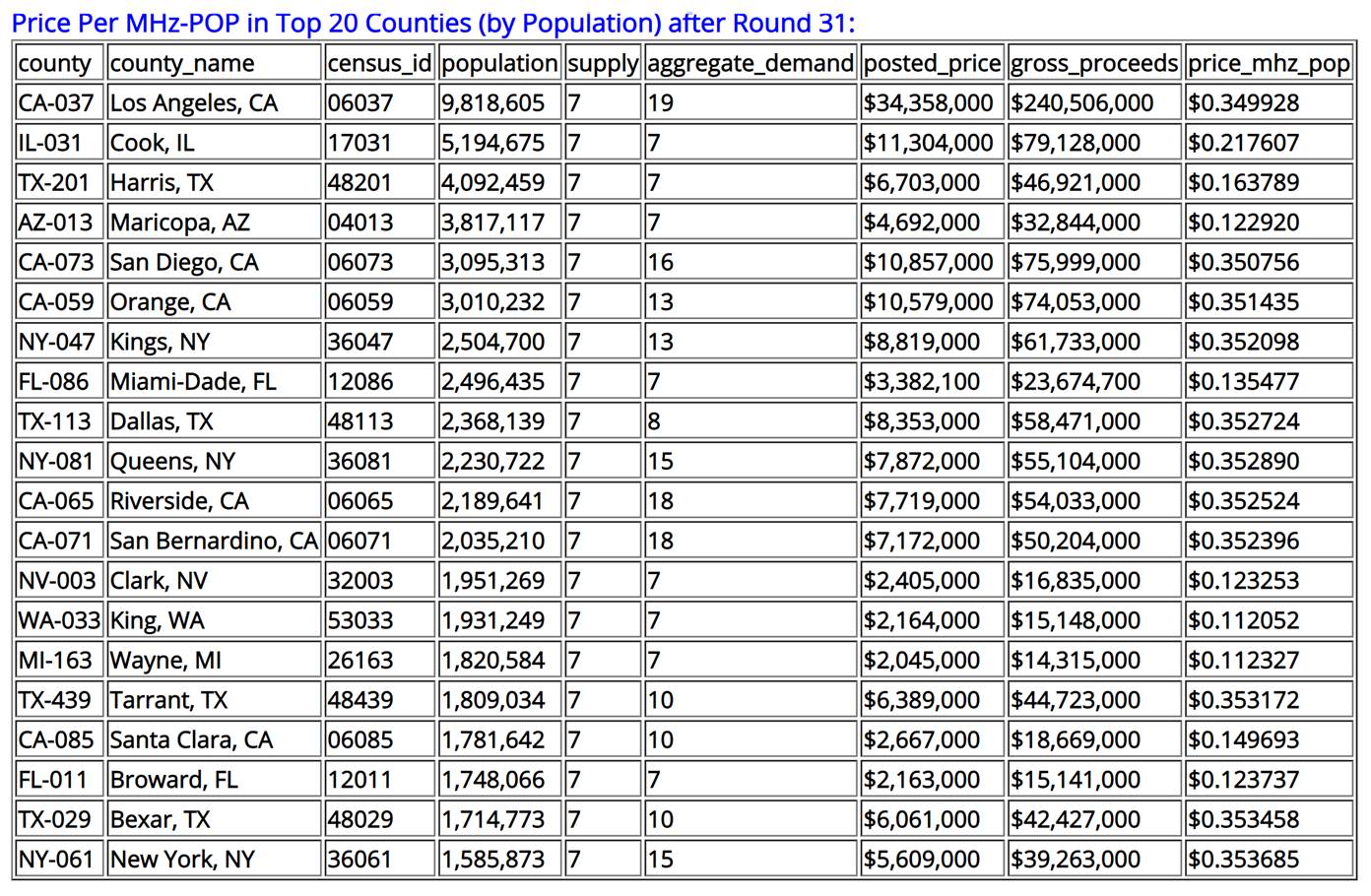Greetings again from Charlotte/ Lake Norman. Pictured is a double rainbow from July to celebrate a week of consistent market highs as well as a pretty darn good first earnings report from T-Mobile. We will analyze four key parts of their conference call, then close with another CBRS auction update.
The week that was
Note: We are truing up the share counts to reflect current quarterly earnings releases. No material changes compared to previous weeks but please note the new column.

Apple gained over $80 billion this week and, with Facebook (+$44 billion), led most of the Fab 5 gains (now more than $2 trillion for 2020, with half of that added over the last six weeks). At this pace, this year’s Fab 5 gains will eclipse the entire value of the London Stock Exchange (which is worth slightly more than $4 trillion as of the end of July).
While smaller in scale, the Telco Top 5 also posted broad-based gains this week and are nearly back to their end of 2019 aggregate capitalization level. T-Mobile gained $9 billion this week on stronger than expected earnings (described below), and Charter and Verizon each grew $5 billion. As the week-over-week table nearby shows, it has been a slow but steady ascent for the Telco Top 5 over the past 12 weeks. Charter (+$65 billion) and T-Mobile (+$58 billion) have together created significant value for shareholders over the last 19 months (~$123 billion) while AT&T and Verizon have created $22 billion each over the same period (excluding dividends paid).
Last week, we started to examine the underlying financial metrics for the Fab 5, covering Apple, Alphabet and Amazon. Strong cash flows from operations and robust liquidity (far more cash on hand than indebtedness) were consistent themes for each of the three evaluated last week. This week. Google/ Alphabet ($117 billion negative net debt balance) raised $10 billion in additional debt which included 10-yr debt at 1.1% yields and 40-yr debt at 2.25% yields. The proceeds from this raise will be used to fund Environmental, Social, and Governance (ESG) initiatives and also provide additional funds to provide affordable housing in the Valley and to promote entrepreneurship for minorities. Money raised for good causes at best-ever interest rates – some good news in the midst of COVID-19.
 Microsoft and Facebook also have strong cash flows and excellent liquidity. The Redmond, Washington, software company has had a long history of both trends, with annual cash flow from operations growth of 16% and net debt improving to -$73.2 billion.
Microsoft and Facebook also have strong cash flows and excellent liquidity. The Redmond, Washington, software company has had a long history of both trends, with annual cash flow from operations growth of 16% and net debt improving to -$73.2 billion.
The magnitude of these balances puts the Metaswitch and Affirmed Networks purchases into perspective – Microsoft is buying telecom expertise to develop world-class enterprise and carrier cloud-based switching software. Combine that spending (the combined purchase price was likely in the $1.2-$1.6 billion range) with over $19 billion in R&D over the past year ($50 billion over the past three years) and more than $15 billion in PP&E spending over the same period and the task of making Azure Private Edge a competing telecom product looks very achievable.
While it’s still hard to fathom that Microsoft has created more than three Verizon equivalents of value in the last 19 months, their earnings show strong growth with plenty of cash for additional investments.
 Facebook’s equity market value accelerated during the last month (+$80 billion the last four weeks – 44% of their total $180 billion in 2020) despite a growing list of companies (including Microsoft) participating in July’s ad boycott. Interestingly, we could only identify one ad agency – Goodby Silverstein – in our research. One way companies could circumvent the boycott (although it would be easily identified) would be to halt direct ad buys from Facebook and instead purchase through their agency. Some of our friends in the ad placement industry indicate that this is exactly what’s occurring. Such activities limit the boycott’s effectiveness. More on who is continuing to boycott and who is returning to the social media giant in this CNBC article.
Facebook’s equity market value accelerated during the last month (+$80 billion the last four weeks – 44% of their total $180 billion in 2020) despite a growing list of companies (including Microsoft) participating in July’s ad boycott. Interestingly, we could only identify one ad agency – Goodby Silverstein – in our research. One way companies could circumvent the boycott (although it would be easily identified) would be to halt direct ad buys from Facebook and instead purchase through their agency. Some of our friends in the ad placement industry indicate that this is exactly what’s occurring. Such activities limit the boycott’s effectiveness. More on who is continuing to boycott and who is returning to the social media giant in this CNBC article.
Facebook’s boycott is also having another effect – challenger brands (many of them smaller companies) are advertising. QuickBooks, Moe’s Southwest Grill, ADT, and even electric car start-up Nikola Motors all appeared in my recent feed along with every vitamin supplement known to mankind. As we indicated in the July 12 Sunday Brief, the impact of this boycott to the company and its shareholders is far less than its media coverage.
We reiterate the Fab 5 common threads from last week’s column:
- High investment (even during COVID-19) to create continued competitive advantage
- Selective broadening of markets (e.g., iPhone SE, Apple Card, Azure Private Edge, TikTok?) over time
- These investments result in increased scale economies to handle faster growth
- Global exposure (and global investments) which de-risk singular geographic exposure (but expose companies to increased foreign exchange volatility)
- Freedom to operate in an increasingly (American) deregulatory environment
- Because of a-e, ability to hire the most talented people across the globe
- Negative net debt and strong cash cushions.
These are main threads that weave the value-creating fabric of the Fab 5.
And then there were three – wireless in 2020
T-Mobile announced earnings on Thursday which were viewed positively (full package here). It’s very difficult to trend out anything with the new T-Mobile except for lowered churn – hence the title of this week’s Brief and this section in particular. One less competitor creates an opportunity for both Dish (Boost, and now Ting) as well as cable companies to fill the void. While we continue to have questions on Dish, we think that cable (including Cox) will come out swinging once the CBRS auctions have ended.
Here are four takeaways from T-Mobile’s earnings announcement (and earnings in general):
T-Mobile designed their new “4 for $25” Essentials plan to attract budget-conscious families (we referred to them as “The Frozen, Anxious Middle” in a previous Brief). Many of them are staying close to home this summer and fall (minimizing Hotspot needs) and T-Mobile’s metro area coverage still ranks high in nearly every speed test. This plan provides a promotional rate floor for many cost-conscious families to consider. Compared to Verizon’s and AT&T’s lowest priced plan ($140 for four lines and Verizon’s does not include 5G), $480 in savings per year is compelling.
What this plan provides in addition to cost savings is a vehicle to purchase 5G devices without increasing the customer’s total bill. In addition to earnings, T-Mobile also announced that they are offering the Samsung Galaxy A51 and A71 5G devices (which already carry aggressive trade-in promotions). Having sub-$30/ mo. devices makes the leap to 5G speeds a lot easier to swallow for a family. And, if the upcoming Apple 5G device is the only thing that will do, there will be a few hundred dollars more to defray its cost.
Bottom line: “4 for $25” gets attention and warrants investigation. It will likely result in switchers and small to moderate increases in 5G device adoption. It also will serve as a terrific retention tool for some legacy Sprint families.
- T-Mobile expects higher churn in the second half of the year as customers move out of their homes and start to consider other alternatives. While many analysts got very excited about T-Mobile’s postpaid phone churn (0.8% including Sprint), EVP and CMO Matt Staneff was quick to attribute a lot of the change to COVID-19:
“It’s a great number to have in the first quarter [after the merger]… T-Mobile was among the leaders in the category and as you said, Sprint was in the high ones… But Q2 is a bit of an anomaly and you’ve seen that across the industry in terms of what churn has done. We have been very hard at work. We’ve been talking about what we’ve done, getting the Sprint customer base access to the network. We’ve got 10 million customers kind of on a daily basis using the network… We provided VoLTE with a much better experience and we’ve been hard at work giving value to the Sprint customer base. And taking un-carrier principles and deploying them pretty broadly across the base… And I can’t predict where churn will go, but what I can say is that things we need to get to where it was at 0.80 last quarter, we are going to keep doing and more of as we move forward.”
This is a way to build an expectation of “low ones” churn on a combined basis and to come in at 0.90-0.95%. Our guess is that July and August will continue to be lower than expected as promotional activity is muted by the pandemic, but that a few more content-hungry Sprint customers will look for other providers.

- T-Mobile’s expectations for a wireless rebound in small business are big. Mike Sievert wants to beat Comcast and Charter to the punch on small business and enterprise plans. To date, it’s important to note that T-Mobile has not had to compete against cable bundles. Here’s one of Mike’s comments from the conference call on the overall business environment:
“Everybody is looking for dollars and looking under every rock to find them. And here we are at just that moment, with the best value and the highest capacity service… CL, corporate liable part of our market is kind of been flat lined for a long time. And I actually think that post-COVID, there is an opportunity that the changing work styles will cause us to see growth again in that sector, just at the time we are arriving with hyper competitiveness and able to lead the pack… Some form of home work and home officing is going to continue and some amount of that will carry on and companies will feel more of a need than in the past to take responsibility for some of the home connectivity and personal connectivity of their employees. That means enterprise corporate liable lines may be positively responsive to this environment. That’s always been a castle of AT&T’s and Verizon’s. But it’s ours to take and we are scaling the walls.”
To fulfill this vision, T-Mobile will need to plan for customer work from home or WFH needs (interestingly, there is no WFH messaging on the T-Mobile for Business site). These include application integration (Microsoft server connectivity for Teams), performance neutral security, and aggressive pooling plans that eliminate the need for any worries about overage costs. The WFH solution needs to include voicemail to text, callback reminders, and easy to integrate Salesforce integration.
The greatest business asset that T-Mobile should leverage is their Softbank and Deutsche Telekom ownership. Best connectivity to Japan (3rd largest economy in the world: $5.2 trillion) and Germany (4th at $4.2 trillion) should be a given. It’s an easy source of competitive differentiation, and a clear sign that T-Mobile USA is part of the global business landscape. For a more in-depth discussion of the leverage opportunities that exist, see this Sunday Brief.
- T-Mobile is not moving into acquisition mode (although it has the balance sheet to do so). In response to Bill Ho’s question about the potential for additional strategic acquisitions, Mike Sievert commented:
“I like being a pure play… we’re focused and we’re disciplined… Wireless is where things are going. You’ve heard us say, John Legere said for years, you’ve heard us say over and over, all content in communications of all kind are leaving their linear forms and going to the Internet and the Internet is going mobile. Mobile is eating the internet. And so, as a mobile pure play, that’s a great place to be.
Now, on the other side of it, I’ll just say, while we are focused and disciplined, we have a fantastic balance sheet. … an incredible source of strength and so, we won’t be obtuse to strategic opportunities if they make sense in our business model. But I think you are investing in this company, because you see that we have an opportunity to win in this huge market and we intend to focus and to do just that.”
One of the greatest assets T-Mobile has is an appreciating stock price. As shown above, they have created around $58 billion in additional market capitalization in less than two years and are knocking on the door of $150 billion in total equity market value ($20 billion more than IBM). TDS + US Cellular is less than $7 billion opportunity even with a healthy premium and that would fill in a lot of rural markets. No doubt, reducing current leverage to the “twos” is a priority, but once that it is in sight (and Neville Ray clearly outlined their plans on the call), why not look at “tucking in” US Cellular or Rogers ($2.3 billion equity market cap)?
Bottom Line: One less carrier makes a lot of difference, particularly in the family plan segment. T-Mobile has a lot of integration to do, but this is actually an easier transition than Metro was. The team was remarkably comfortable (especially the new CFO, Peter Osvaldik) and provided 2H guidance one quarter after completing the Sprint merger. But there’s a lot of synergy attainment left to complete, and more demonstration of enterprise growth is needed (which will require fiber and application partnerships). To use a puzzle analogy, having the edge pieces in place is good, but there’s a lot of remaining pieces to be placed before this merger translates into meaningful market leadership.
CCBRS auction results: Round 31 ends – total bids now exceed $2.6 billion (+$1.5 billion wk/wk)
There were few dropouts this week in the CBRS auction process. As noted by Sasha Javid in his excellent CBRS tracker here (and pictured below), some of the largest population centers have supply/ demand balance:

Assuming Verizon is highly active in each of these markets, that begs the question “Did Verizon and Comcast split the 70 MHz supply in those markets where demand and supply are equal, or is another dynamic in play?” It’s very interesting to see that Cook, Harris, Miami-Dade, King, Wayne, and Broward counties (demand equals supply) are all Comcast serving territories. Outside of Santa Clara county (probably some Google activity going on there), there are no counties listed where demand exceeds supply and Comcast is the dominant provider.
This is not the case with Charter (Los Angeles, Kings, Queens, Orange (with Cox), Tarrant, Bexar, and New York above) and Cox (San Diego, Orange). Our guess is that Verizon and a cable company are splitting many of these markets, with additional interest from AT&T, particularly in Los Angeles and San Diego.
More to come next week after round 46.
That’s it for this edition of The Sunday Brief. Next week, we will wrap up the remaining earnings reports and begin our three-part series on post-pandemic growth. Until then, if you have friends who would like to be on the email distribution, please have them send an email to sundaybrief@gmail.com and we will include them on the list (or they can sign up directly through the new website).
Stay safe and keep your social distance!
The post The Sunday Brief: And then there were three–wireless in 2020 appeared first on RCR Wireless News.
